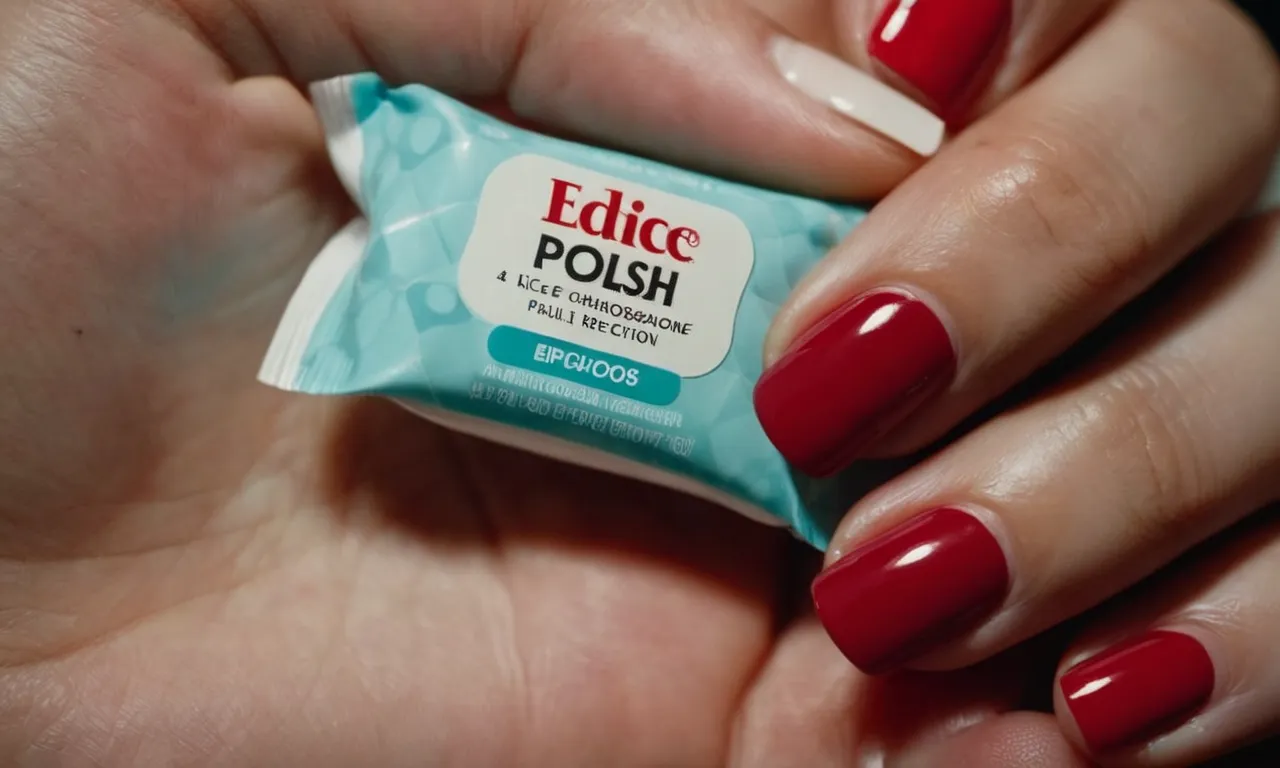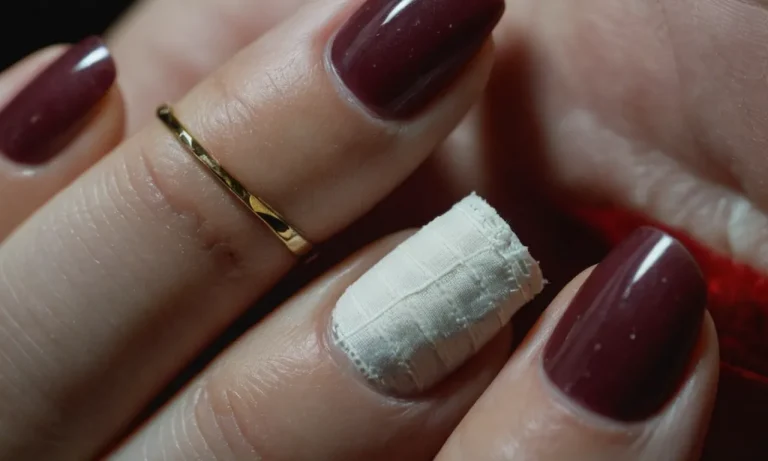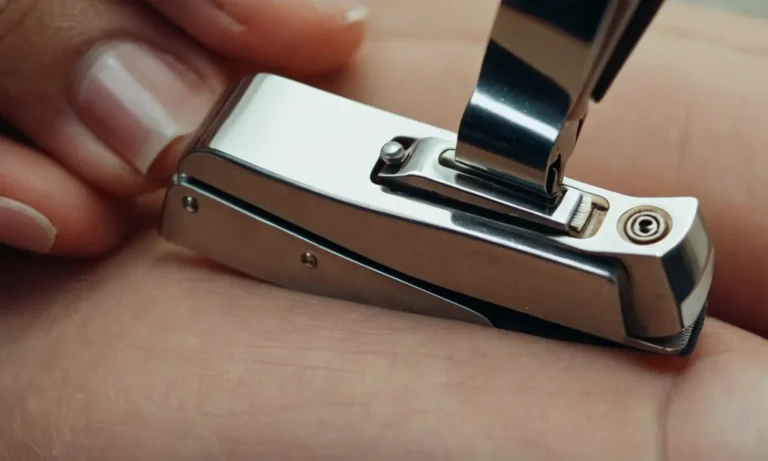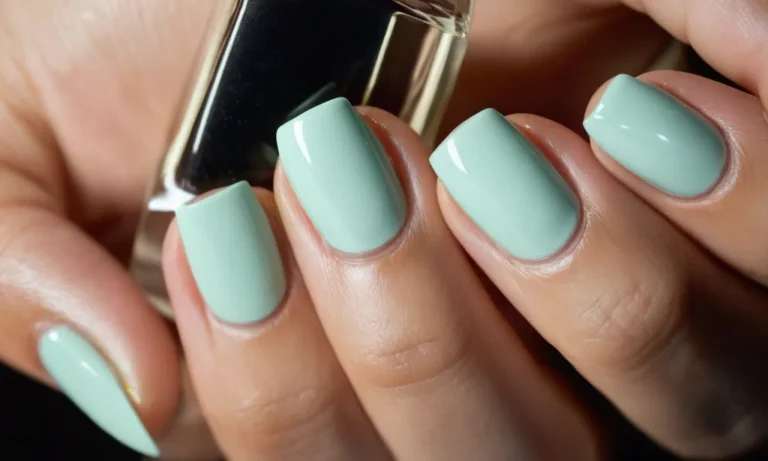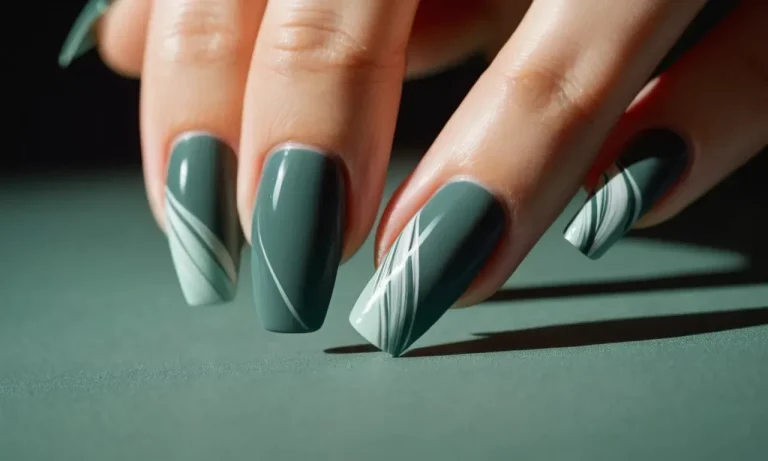How To Treat An Allergic Reaction To Gel Nail Polish
If you got your nails done recently and noticed redness, swelling, bumps, itching or other irritation around the nails, you may have developed an allergic reaction to the gel nail polish. While gel manicures create a durable, long-lasting color with a glossy finish, the chemicals in the gel can cause contact dermatitis in some people.
Thankfully, there are steps you can take at home to soothe the reaction and speed healing.
Here’s a quick answer on how to treat a reaction to gel nails: Remove any remaining gel polish right away using acetone remover. Take an antihistamine for itching. Apply a cold compress and hydrocortisone cream to reduce swelling and irritation. Moisturize often and avoid irritants until healed.
See a doctor if symptoms worsen or persist.
Recognizing the Signs of an Allergic Reaction
Itching, redness and swelling around the nails
One of the first signs that you may be having an allergic reaction to gel nail polish is noticing itching, redness, and swelling around the nails and cuticles. This is caused by the skin becoming irritated by ingredients in the gel polish, especially the acrylates found in many gel polishes which are a common allergen.
The skin around the nails is very sensitive, so reactions often show up here first. Don’t ignore these early warning signs – if the itching and redness continues, it likely means you need to stop using the gel polish.
Bumps, blisters or hives on fingers
More serious allergic reactions may cause bumps, blisters or hives to appear on the fingers, hands, or any skin that came in contact with the gel polish or remover. This is a sign of contact dermatitis, where the skin has become sensitized to an allergen and reacts by developing a rash.
Blisters are especially concerning, as they can ooze and become weepy or crusty. If you notice any bumps, blisters or hives after getting a gel manicure, avoid getting another one and see a doctor to get proper treatment. Leaving the reaction untreated risks the blisters becoming infected.
Burning or stinging sensation
Some people report a burning or stinging sensation around the nails or cuticles when getting a gel manicure, especially during the gel polish application or when it is cured under the UV or LED lamp. This hot, prickly feeling indicates an irritation is occurring and is likely an allergic response brewing.
For most clients who describe this reaction, it tends to worsen with each repeated exposure to gel polishes. Listen to these warning signs from your body and consider switching to regular or dip powder manicures to avoid escalation of symptoms.
Nails lifting from nail beds
While some nail lifting after gel polish application can happen due to improper prep or application techniques, if it occurs repeatedly and is accompanied by other symptoms like redness and itching, it may signal an underlying contact allergy.
The inflammation and reaction occurring can cause the bond between the natural nail and the gel polish to break down faster. Frequent nail lifting that leaves you with raised, swollen cuticles is a sign that you should see your doctor to be tested for allergies.
Continuing gel manicures will likely just exacerbate the reaction.
Increased sensitivity, tenderness when pressure applied
Many people with gel polish allergies report increased nail and cuticle sensitivity, with even light pressure causing tenderness or pain. Whereas regular manicures do not cause pain, gel manicures leave clients flinching when cuticles are pushed back or nails are filed.
This hypersensitivity develops from the ongoing allergic irritation and inflammation. Listen to these symptoms and avoid further trauma to the area by stopping gel manicures. See a dermatologist to help identify the allergy source and follow treatment recommendations to allow healing.
Removing the Gel Polish Promptly
When suffering an allergic reaction to gel nail polish, it is crucial to remove the polish as soon as possible. The offending chemicals must be eliminated from contact with the skin to halt the reaction. Using pure acetone remover is the most effective method.
Use pure acetone nail polish remover
Acetone works by breaking down the bonds of the gel polish. Opt for pure acetone with no additives, which may further irritate the skin. The average nail salon remover contains only a small amount of acetone diluted in other chemicals and oils.
For a gel reaction, go to the pharmacy section of stores like Walgreens or CVS to find 100% acetone.
Soak nails for 15-20 minutes
Fill a small bowl with enough acetone to submerge the nails. Cotton balls may be used for individual fingers. Soak for 15-20 minutes to allow the acetone to fully penetrate the layers of polish. This softens the gel to make removal easier and prevent damage to natural nails.
Set a timer as the acetone can dry out skin and nails if left too long.
Gently scrape off gel with wooden stick
Once adequately soaked, begin gently sliding a wooden cuticle pusher or orangewood stick under the gel to lift it from the nail plate. Apply slight pressure to detach it without scraping too forcefully. Metal tools may further irritate skin.
Work slowly and carefully, reapplying acetone as needed until all traces lifted. The process may take up to an hour for a full set.
Repeat soaking and scraping until all gel lifted
It often requires repeating rounds of soaking and gentle scraping for thorough removal. Check for any remaining tacky residue indicating not all the gel was eliminated. If present, do another 5-10 minute soak of those nails and use the stick to remove the last bits of stubborn polish.
Rinse nails and apply moisturizing cream when done
When removal finished, thoroughly rinse nails with lukewarm water and gently pat dry with a lint-free towel. Follow up by massaging in a rich moisturizer like Aveeno Daily Moisturizing Lotion or O’Keeffe’s Working Hands Cream. This helps restore moisture and provides relief to aggravated skin.
Continue applying cream multiple times a day while skin heals.
Taking Antihistamines for Itch Relief
Allergic reactions to gel nail polish often result in itchy, irritated skin around the nails. Antihistamines like Benadryl can provide relief by blocking the release of histamine, which is responsible for many of the symptoms.
Here’s a closer look at how antihistamines can help when you have an allergic reaction to gel manicures:
Antihistamines like Benadryl block histamine release
Histamine is one of the main chemicals released during an allergic reaction. It binds to receptors on cells and causes effects like itching, swelling, and redness. Antihistamines work by blocking histamine receptors so the histamine can’t bind and cause symptoms.
Benadryl (diphenhydramine) is one of the most common oral antihistamines used for allergic reactions.
Help reduce redness, swelling and itching
By blocking histamine, antihistamines can provide relief from irritating allergy symptoms. Studies show oral antihistamines like Benadryl can help:
- Reduce redness and swelling at the allergy site
- Relieve itching and skin irritation
- Calm down hives or skin welts
This helps create a more comfortable environment while your immune system clears the allergic reaction.
Take oral antihistamine tablets as directed
Oral antihistamines like Benadryl come in tablet form. It’s important to take them as directed on the package:
- Take the recommended dose for your age and weight
- Don’t take more than directed without consulting your doctor
- Avoid driving or operating heavy machinery as some antihistamines may cause drowsiness
You can also ask your pharmacist or doctor for advice on dosage and the best antihistamine for your situation.
Use anti-itch creams with pramoxine or menthol
In addition to oral antihistamines, topical creams can provide targeted itch relief. Look for creams containing:
- Pramoxine – helps relieve itching by temporarily numbing nerve endings in the skin
- Menthol – provides a cooling sensation to override itchy sensations
Apply sparingly to affected areas a few times a day for extra relief from itching and skin irritation.
Avoid scratching, which can worsen reaction
It can be tempting to scratch the itchy rash around your nails. However, this can make the reaction worse by damaging the skin and spreading the irritation. Try to resist scratching and keep nails short and smooth to reduce harm if scratching instinctively.
The above measures can help manage the urge to scratch.
Applying Cold Compresses to Soothe Inflammation
Inflammation is a common side effect of allergic reactions, and applying something cold is an easy way to find relief. Here’s how to use cold compresses to soothe the inflammation caused by an allergic reaction to gel nail polish.
Cold helps constrict blood vessels and reduce swelling
When you apply something cold like ice cubes or a cold compress to an inflamed area, it causes the blood vessels to constrict. This reduces blood flow to the area, which in turn decreases swelling and inflammation.
Using cold therapy can provide significant relief when dealing with an allergic response.
Wrap ice cubes or freeze water in paper towel
To make a cold compress, fill a plastic bag with ice cubes or put ice in a plastic bag then wrap it in a paper towel or thin cloth. You can also freeze water in a paper cup, then peel off the top of the cup to expose the ice.
Wrapping the ice prevents direct contact with the skin, avoiding risk of ice burn.
Apply cold compress for 10-15 minutes several times a day
For maximum relief, apply the cold compress or ice wrapped in cloth to the affected area for 10-15 minutes, then remove it for 10-15 minutes. Repeat this several times a day as needed. Going longer than 15 minutes may damage skin tissues. Be sure to check regularly for signs of frostbite.
Always wrap compress to protect skin from freezing
Even though skin inflammation really improves with cold therapy, you always want to protect the skin by wrapping the ice or cold compress in a towel or other cloth barrier. Applying something freezing directly to the skin can cause more irritation and damage.
Follow guidelines for length of application as well.
Using cold compresses is an easy, inexpensive way to manage inflammation from an allergic reaction to gel manicures or nail enhancements. Just be sure to wrap the ice or cold pack to protect the skin and limit application to 10-15 minutes at a time.
This should provide significant relief from the swelling and discomfort.
Using Hydrocortisone Cream to Control Irritation
Hydrocortisone is a mild topical steroid that fights inflammation
Hydrocortisone cream is an over-the-counter treatment that can help relieve itching and inflammation from an allergic reaction to gel nail polish. Hydrocortisone is a mild corticosteroid that works by reducing swelling and redness.
When applied to the skin, hydrocortisone cream helps constrict blood vessels, which decreases blood flow to the area. This helps reduce inflammation that causes symptoms like redness, swelling, and itching.
Look for 1% concentration cream without additives
When purchasing hydrocortisone for an allergic reaction, look for a 1% concentration cream without any added fragrances, dyes, or other ingredients. The 1% concentration contains 10 mg of hydrocortisone per 1 gram of cream and provides anti-inflammatory relief without being too strong.
Some creams contain aloe or vitamin E, which can further soothe and moisturize irritated skin. But avoid products with dyes, perfumes, or other additives that may further aggravate the allergic reaction.
Gently apply small amount to affected areas 2-3 times daily
Only a small amount of hydrocortisone cream is needed to treat an allergic reaction. Use your finger to gently dab a thin layer onto the affected area 2-3 times per day, or as directed on the packaging.
Take care not to rub the cream vigorously or apply too much, as this can further irritate the skin. The cream should be lightly patted and absorbed into the skin for best results.
Continue using for 2-3 days after symptoms subside
Hydrocortisone cream usually starts working within a few days to relieve allergy symptoms. But it’s important to continue applying it for 2-3 days after the swelling, redness, and itching have gone away to ensure the reaction has fully resolved.
If symptoms do not improve within 7 days of using hydrocortisone as directed, you may need a stronger prescription steroid cream to control the reaction. See your doctor if the allergic reaction persists or worsens.
Moisturizing Hands and Applying Protective Ointments
Allergic reactions can dry out the skin around nails
When you have an allergic reaction to gel polish, the skin around your nails can become red, itchy, scaly, and extremely dry. This is because the reaction causes inflammation that damages the skin barrier. Without proper moisture, the skin is left raw and vulnerable to cracking and infection.
Frequently moisturizing is key to soothing the irritation and restoring suppleness.
Frequently apply fragrance-free lotions and creams
Dermatologists recommend gently massaging fragrance-free moisturizers into the skin around nails at least twice a day. The best options are rich, emollient lotions and creams that create a protective seal over the skin without irritating it further.
This helps retain moisture and prevents loss of hydration. Over-the-counter brands like Eucerin, Aveeno, Cetaphil, and Vanicream are great choices.
Petroleum jelly creates protective barrier for sensitive skin
In addition to moisturizer, applying a layer of petroleum jelly like Vaseline to the affected skin can help relieve uncomfortable dryness and shield it from external irritants. With its thick, waxy texture, petroleum jelly adheres nicely and makes an impermeable seal that prevents moisture evaporation.
It’s hypoallergenic and unlikely to cause further problems. You can dab it onto the nail folds and cuticles as needed whenever they feel tight or sore.
Wear gloves for wet work to avoid irritation
While your hands heal, it’s wise to wear cotton gloves when washing dishes, cleaning, or performing other wet tasks. Exposure to hot water, detergents, and chemicals can strip away natural oils and upset the skin’s moisture balance.
Vinyl gloves trap sweat and bacteria next to the skin, worsening irritation. But breathable cotton gloves provide an extra barrier against environmental irritants as the nails and skin recover.
When to See a Doctor for Allergic Reaction to Gel Manicure
If symptoms don’t improve within a few days
If you develop mild symptoms like redness, swelling, or itching after a gel manicure, you can try treating at home with cold compresses, oral antihistamines, and hydrocortisone cream. However, if symptoms persist beyond a few days without improvement, it’s important to make an appointment to see your doctor.
Allergic reactions that don’t get better on their own can sometimes lead to chronic conditions like dermatitis. Left untreated, these reactions may also spread and worsen over time. Seeing a doctor allows them to properly assess your reaction, determine if you need oral steroids or other treatments, and help prevent complications down the line.
You develop signs of infection like pus or fever
If the skin around your nails becomes increasingly red, swollen, painful and develops pus or oozing, this indicates a skin infection has set in. Other signs include fever, chills, fatigue and skin that is hot to the touch.
Skin infections require prompt medical treatment with antibiotic therapy to prevent the infection from spreading deeper or to the bloodstream, so seeing a doctor right away is recommended.
According to the American Academy of Dermatology, some people are at higher risk for developing skin infections around the nails, including those with weakened immune systems, diabetes, or peripheral vascular disease.
These individuals should be especially alert for signs of infection and ready to seek medical attention at the first symptoms.
Reaction is severe with widespread hives, swelling or difficulty breathing
Severe allergic reactions to gel manicures can occasionally occur, including potentially life-threatening reactions like anaphylaxis. Signs include hives or rash spreading across large areas of the body, swelling of the face/throat, wheezing or difficulty breathing, a drop in blood pressure, dizziness or fainting, chest pain, nausea or vomiting.
If you experience any severe symptoms that suggest anaphylaxis shortly after a gel manicure, call emergency services or go to an emergency room immediately. Severe reactions can progress rapidly and close off the airways without swift emergency epinephrine and medical treatment.
Don’t attempt to drive yourself or wait it out.
You have recurrent reactions and sensitivity to products
Some ingredients commonly found in gel nail products like (meth)acrylates are significant contact allergens, meaning they can trigger allergic reactions in those with sensitivities. If you’ve experienced allergic reactions to multiple gel manicures or have reactions even when avoiding certain products, it’s a sign you’ve developed an allergy.
Seeing an allergist and getting patch testing done can help identify specific chemical triggers. Once identified, you can then avoid products containing those ingredients. Without identifying specific allergens though, you’ll continue having repeated reactions.
Some studies have found rates of contact allergy to nail gel ingredients ranging from 2% to 10% of those getting frequent gel manicures. Women with persistent rashes, redness, swelling, peeling or itching around the nails should consider patch testing to uncover possible gel product allergies.
Conclusion
While gel manicures can cause annoying and painful reactions in those with sensitivities, there are several effective at-home steps you can take to treat the irritation. Removing the polish right away, taking antihistamines, applying cold compresses, using hydrocortisone cream and moisturizing hands frequently will help minimize discomfort and promote healing.
Avoid further exposure to the irritating gel ingredients. See a doctor promptly if your reaction is severe or persistent. With proper treatment, your fingers should be reaction-free before your next manicure appointment rolls around.

